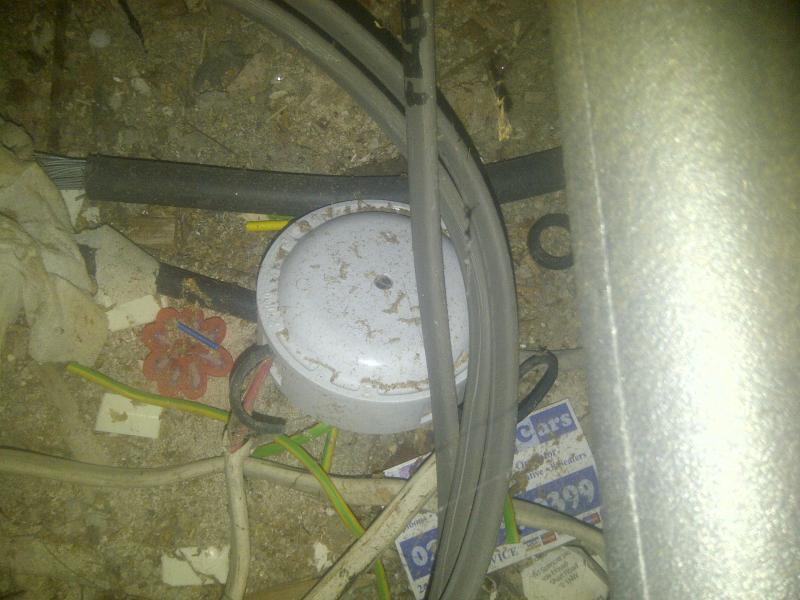Well it looks like I may have been running on a ring with a loose connection for a while. And a 2nd fault has caused a complete break in the ring. The electrician was able to locate the section and I remembered a screw down junction box under the floor (near the CU). So floor up, screw tightened and problem solved. I found another 2 junction boxes in the same floor space - 1 which needed tightening (hopefully the 1st fault). Electrician coming back to take some reading on the ring. Thanks
You are using an out of date browser. It may not display this or other websites correctly.
You should upgrade or use an alternative browser.
You should upgrade or use an alternative browser.
One Ring Failing - Anything I can check?
- Thread starter 4candles
- Start date
Great.!
That proves the requirement for junction boxes to be accessible!
As you have found out, quite often, the JB has been hidden under the floor for a decade or two (or buried in the wall ) and nobody knows it is there.
) and nobody knows it is there.
That proves the requirement for junction boxes to be accessible!
As you have found out, quite often, the JB has been hidden under the floor for a decade or two (or buried in the wall
So I see.
What's the story with that armoured cable above the JB? I can see the steel armour, I hope there aren't bare conductors coming out of the end

What's the story with that armoured cable above the JB? I can see the steel armour, I hope there aren't bare conductors coming out of the end
That's an old armored cable (replaced when extension went in)
Electrician came back to test, still had a neutral fault between last socket and CU. He worked out which wire it was on. Wire disconnected, now converted to a radial and downgraded MCB from 32 to 20.
He said that was best.
Electrician came back to test, still had a neutral fault between last socket and CU. He worked out which wire it was on. Wire disconnected, now converted to a radial and downgraded MCB from 32 to 20.
He said that was best.
Best option if you don't want the hassle of replacing the damaged leg. Not necessarily the BEST solution but not the worst.
Do you only have one radial circuit then? Would indicate the break was on a leg from the cu to the first/last point and may not be that hard to fix
Do you only have one radial circuit then? Would indicate the break was on a leg from the cu to the first/last point and may not be that hard to fix
That's certainly what the OP said ...... Would indicate the break was on a leg from the cu to the first/last point ...
... still had a neutral fault between last socket and CU.
Seemingly not too easy, either. Maybe there is a problem of access to that run of cable?... and may not be that hard to fix
Kind Regards, John
Oh may bad. Didn't read that post very well at all.
Shame it wasn't a mid ring break. Sometimes two radials are better that one ring final
Shame it wasn't a mid ring break. Sometimes two radials are better that one ring final
People say that, but I don't really understand what the perceived advantage is meant to be. If we were talking about 32A radials, that would be different, but a 20A sockets circuit seems a bit iffy to me, in as much as it theoretically can only support about 1½ 13A loads.Oh may bad. Didn't read that post very well at all. Shame it wasn't a mid ring break. Sometimes two radials are better that one ring final
Kind Regards, John
That's worse (in terms of power availability). It ought to be able to be at least 20A (possibly 25A if one is available for your CU). Regulations require that the current-carrying capacity of cable used in a ring must be at least 20A, so a 20A MCB ought to be fine.my mistake it was a 16 amp MCB
Kind Regards, John
It was a ring, until the electrician disconnected the cable between the last socket and the CU, turning it into a single radial. As I said, if it used to be a reg-compliant ring, the CCC of the cable would have to have been at least 20A, so the newly created radial should be able to have at least a 20A MCB, if not (depending on cable installation method and MCB availability) a 25A one.It's not a ring.
Kind Regards, John
DIYnot Local
Staff member
If you need to find a tradesperson to get your job done, please try our local search below, or if you are doing it yourself you can find suppliers local to you.
Select the supplier or trade you require, enter your location to begin your search.
Please select a service and enter a location to continue...
Are you a trade or supplier? You can create your listing free at DIYnot Local


